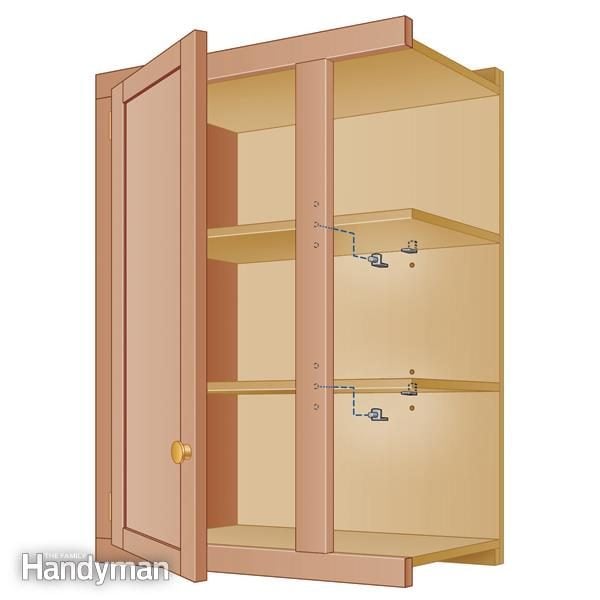

Fixing sagging cabinet shelves is a common household problem, often encountered in kitchens, bathrooms, or pantries. Sagging shelves not only compromise the aesthetic appeal of your cabinets, but also pose a safety hazard, making them prone to damage and injury. This comprehensive guide will walk you through the process of identifying the causes of sagging shelves, evaluating the extent of the problem, and providing practical solutions to effectively address the issue. From simple adjustments to more involved repairs, we’ll cover several methods. Let’s get started on restoring your cabinet shelves to their former glory! This article will cover a wide array of fixes, from simple adjustments to more complex repairs, depending on the cause of the sag. We’ll discuss the types of sagging, their causes, and the specific steps to tackle each type.
Identifying the Causes of Sagging Shelves
Understanding the Root of the Problem
Sagging cabinet shelves are often the result of several factors. The weight of the items stored on the shelves, improper installation, or the material’s inherent weaknesses could contribute to the issue. A detailed inspection is needed to accurately determine the problem. For instance, an unevenly supported shelf might be more prone to sagging due to misalignment of the supporting components. Heavy items placed in an uneven distribution, especially in the center of the shelf, can also become a contributing factor. A proper understanding of the cause will guide you to the right solution, so let’s look at some of the reasons why shelves sag.
Materials and Construction
Different materials like wood, metal, or composite materials react differently to pressure and weight. Wood shelves, for example, are susceptible to warping, cracking, or splitting under excessive load. The quality of the wood itself plays a significant role. Over time, expansion and contraction due to moisture changes, even temperature fluctuations, or inappropriate storage conditions can affect the integrity of the wooden structures.
Installation Issues
Issues during installation, like improperly placed support braces or insufficient support altogether, are also common culprits. If your cabinets were built cheaply or the installation was done poorly, the shelves could experience an uneven distribution of weight.
Other Factors
Additional factors that contribute to sagging shelves can include poor quality hardware, the cumulative weight over an extended period, and the way the shelves connect to the cabinet.
Evaluating the Extent of the Sag
Assessing the Damage
Before attempting any repairs, it’s crucial to assess the severity of the sag. A slight bend might be easily fixed, while a significant sag might require more involved solutions. Using a level and a ruler, compare the shelf’s height at various points. Determine if the sagging is uniform or localized. A visual inspection might help determine the cause. Careful examination can save time and money by identifying unnecessary repairs. Is the sag uniform across the entire shelf, or concentrated in specific areas?
Determining the Type of Sag
Understanding the type of sag can affect the approach. Some types of sagging might be resolved with simple solutions while others may need professional assistance. For instance, a shelf with a slight wobble may only require a simple adjustment. On the other hand, a shelf with severe sag might require structural support or replacement.
Simple Repair Methods for Minor Sag
Shelf Leveling
For minor sagging issues, consider adjusting the shelf supports, including the metal clips. Carefully re-level the shelf using shims and screws to ensure even support. Before starting any modifications to the cabinet, it is always a good idea to check the installation manual for proper cabinet care and handling instructions. Proper use of shims will provide extra stability. If the sag is only minor, this could be a great option.
Replacing Support Braces
If the support braces are damaged, loose, or misaligned, replacing them could resolve the problem. Use the correct size and type of brace for your shelf. Precise measurements and correct placement are essential for proper function.
More Involved Repair Techniques
Reinforcing the Shelf
Consider additional support for significant sagging. You can add extra supports, such as installing additional braces, placing heavy items strategically, or adding wood supports to the shelf. A more involved solution that also involves the use of tools and materials.
Preventative Measures for Future Sagging
Distribute Weight Uniformly
Prevent future problems by distributing the weight evenly on the shelf. Avoid stacking heavy items in the middle of the shelf and ensure that the weight is distributed around the support beams to avoid uneven stress. Careful organization can lead to a lasting fix.
In conclusion, fixing sagging cabinet shelves is a manageable task with the right approach. By understanding the common causes, evaluating the severity of the sag, and selecting the appropriate repair method, you can restore your cabinet shelves to their former glory. Remember to prioritize safety and employ the necessary tools for a successful and lasting fix. Don’t hesitate to seek professional help if the issue proves too complex or challenging. Now you’re ready to confidently tackle those sagging shelves and maintain the functionality of your kitchen or storage space. Visit our website for more helpful DIY tips and tricks!